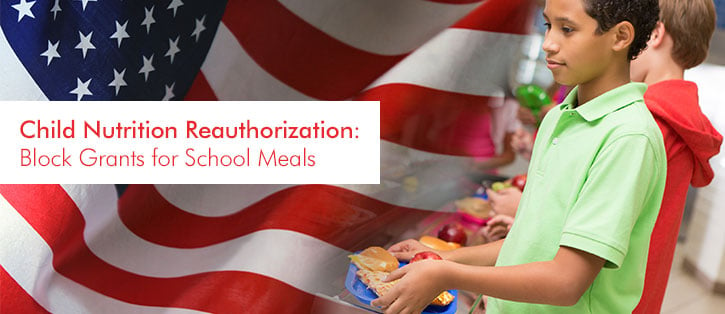
The following post was written by Barry Sackin of Sackin & Associates.
Child Nutrition Reauthorization continues its arduous trek through the legislative process with a new wrinkle. The House Committee on Education and the Workforce marked up its version of CNR in late May. There are a few things in the bill that you will probably find appealing: an increase of 2¢ in breakfast reimbursement; elimination of the Paid Meal Equity provision; no additional reductions in sodium beyond Target 1; periodic reviews of meal standards based on science; and a return to the five year review cycle. But there are two killer provisions in the bill as well: raising the threshold for the Community Eligibility Program (CEP) from 40% to 60%; and a three state, three year pilot for block-granting school meals.
Community Eligibility Program (CEP) Updates
In the Healthy Hunger-free Kids Act of 2010, Congress enacted a provision allowing schools where at least 40% of enrolled children were directly certified for free meals could do away with the application/verification process and claim free meals for 1.6 times their direct certification counts. The 1.6 factor is based on evidence that for each ten children directly certified, approximately 16 are actually eligible. At 40%, that means a school would claim 64% of their meals as free. At 60%, the claim would be 96%. Conservative members of the Committee thinks that at 40% the program is underwriting non-needy meals. The advocacy community has united in opposition to this proposal.
Block Grants
Less than 48 hours before its markup of the CNR bill in the House Committee on Education and the Workforce, subcommittee chairman Rokita presented a revised bill that includes a three-state pilot for block granting school meal programs. Block grants would eliminate all federal laws and rules for school meals and simply send the states a fixed amount of money to feed kids at school. No rules, just wrong. The pilot language would also be a real cut in funding in the pilot states as well by taking away your 6¢ add-on and freezing the amount the pilot states get at this year’s level – no inflation or population adjustments. And states could keep 10% of the funds for “administrative” functions, far more than the current SAE allocation. When this was proposed in 1995 as part of the Contract with America, not only did it fail, it undermined the whole conservative agenda. The three-state pilot in CNR was added to bring the far right members of the committee on board for passing the bill out of committee. Rep. Grothman offered an amendment to make the block grant proposal nationwide instead of a pilot. The amendment failed - 9 ayes to 25 nays. The fact that 9 voted for it is cause for concern. By comparison with the Grothman amendment, Chairman Kline made the three-state pilot sound like a reasonable idea. It’s not.
In the next week or so, Speaker Ryan is going to post a “white paper” on poverty that is likely to include block grants. It will be the blueprint for the Republican agenda to dismantle the safety net. There is concern that CNR and the block grant pilot will be an easy giveaway to the red-meat far right fringe and an opening wedge for moving a bad policy agenda. There is a lot of uncertainty about if, when, and how CNR would move to the House floor and we shouldn’t assume that it won’t go forward or trust that the Senate will kill a bad bill.
What's Next?
Neither the Senate nor the House has scheduled bringing their bills to the floor. And there is not a lot of time left. Between scheduled “homework periods”, a sense of urgency to go home and campaign, and the need to enact must-pass appropriations bills, finding time in an abbreviated calendar seems unlikely. And if both houses pass bills, they must still convene a conference committee to work out the many differences between the two bills and then get both houses to pass the compromise legislation. All of that seems unlikely, although not impossible, in this election year. If they fail to do so, all legislation that has been introduced dies, and we start again from square one.
Stay tuned...
About the author
 Barry Sackin is a school foodservice veteran of more than 35 years. Barry started his career on staff at San Diego Unified School District in 1980. Barry was a director of large districts for several years, at one point overseeing two districts with more than 70 sites and nearly 45,000 students. While serving on the SNA Board of Directors, Barry was asked to join the staff as VP of Public Policy and has since worked on child nutrition policy for the past 20 years.
Barry Sackin is a school foodservice veteran of more than 35 years. Barry started his career on staff at San Diego Unified School District in 1980. Barry was a director of large districts for several years, at one point overseeing two districts with more than 70 sites and nearly 45,000 students. While serving on the SNA Board of Directors, Barry was asked to join the staff as VP of Public Policy and has since worked on child nutrition policy for the past 20 years.








